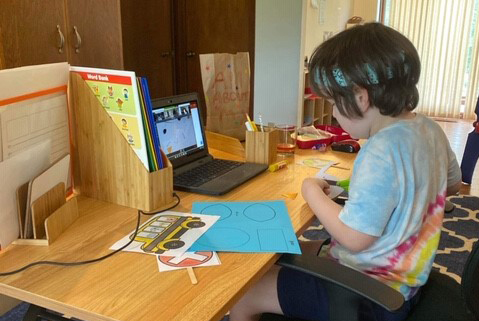Helping Kids Adapt To Remote Learning
It’s that time of year when the leaves change, the temperatures drop, the nights begin to get longer and the days get shorter. It’s time to transition to the new season. This year, everything is different. We’re meeting teachers over Zoom. We’re preparing to learn math on an iPad. School really is starting, but none of us- from the most seasoned teachers to the youngest learners- have done this before!
This year may be hard — it also may be fun and rewarding. Below are some tips to make the transition to remote learning a little less bumpy. Pick out a few ideas that you think will work best for your family:
1. Fill the tank.
Even before a day of remote learning, kids need to connect. Fill your child’s tank for the day with a morning cuddle. As you cuddle, (in their bed, your bed, the couch, your favorite chair), tell them that you are filling their tank and ask questions about their plans for the day. They will let you know, generally within 2-5 minutes, that their tank is full. Talking keeps them from drifting back to sleep but also keeps them curious, engaged, and connected with you. Telling you when their tank is full helps them feel confident and ready for their day.
2. Practice navigating apps and schedules together
Turn on your child’s device over the weekend and ask your child to show you how to find their classroom app. Where do you find new activities? How do you access the daily schedule and links for virtual meetings? Even if you already know how to navigate their online learning platform, pretend like it’s all new to you. Kids LOVE to be the teachers, and it helps them practice! (“Wait, you don’t really know how to find that link for class on Monday again do you?!”)
3. Prep snacks for on-the-go nutrition.
Use a crisper drawer in the refrigerator and one shelf in a cupboard or pantry as a designated place to keep snack items so children can serve themselves when you’re busy during the day and they have a quick break between class meetings.
4. If your child is going to daycare, carefully create your bedtime routine.
Have your child practice plugging in their device (safely!) to charge if they can do so without using it – before bed. If the temptation to get back online is too much at first, you can separate charging from the bedtime routine and practice plugging in earlier in the day. Help them pick out their favorite mask and pack an extra in a plastic bag. What else do they need? Chargers? Water? Snacks and lunch? Create a checklist with your child with words or pictures to help them remember. Adding these steps to your child’s nighttime rituals can help them feel more confident about the day to come.
5. Expect the first month (or two!) to be a little bit bumpy.
The Internet may not work perfectly all the time. You may forget to charge a device. Online meetings may freeze. Children may feel overwhelmed and miss in-person interaction. This is normal and okay. Practice breathing together. Remind yourself and your child that trying is an amazing accomplishment. Reach out to your child’s teacher with questions and concerns. Remember, they’re new at this, too!
And don’t forget to keep connecting with your child: screen breaks, walks, coloring, reading aloud together are all still wonderful ways to remind them that we’ll get through this together.
Remote school is new for everyone! And this school year is going to feel a little bit awkward at first. It takes 2-4 weeks before everybody is more comfortable with new routines during a normal year; during remote school, it will take longer. Even in this challenging time, a few positive routines can still make the transition a little less bumpy.
If you are in need of school supplies or food or technology in order to support your child’s success with remote learning, please contact your school district’s family center. The Family Help Line can help you locate the correct contact information and help you access what your family needs: call or email us at 1-800-932-4673 or familyhelpline@parenttrust.org

